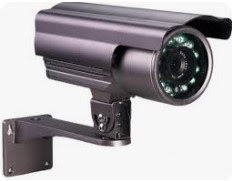A Closed Circuit Television (CCTV) security system is a surveillance technology comprising cameras, monitors, and recording devices used to monitor a specific area or property. It operates on a closed circuit, meaning the signals are transmitted privately to designated monitors or recording devices, rather than being publicly broadcast. CCTV systems have become ubiquitous in various settings, including public spaces, businesses, homes, and government facilities, due to their effectiveness in deterring crime, enhancing safety, and providing evidence in case of incidents.
The components of a CCTV system
typically include:
i. Cameras: These are
the primary components that capture video footage of the monitored area. CCTV
cameras come in various types, such as dome cameras, bullet cameras, PTZ (Pan Tilt
Zoom) cameras, and covert cameras, each suitable for different surveillance
needs and environments.
ii. Monitors: Monitors are
used to display live or recorded footage from the cameras. They allow security
personnel or property owners to monitor activities in real time and review
recorded footage as needed.
iii. Recording Devices: DVRs
(Digital Video Recorders) or NVRs (Network Video Recorders) are used to store
video footage captured by the cameras. These devices enable continuous
recording or motion activated recording, ensuring that events are captured for
future reference.
iv. Cabling and Connectivity: CCTV systems
require cables to transmit video signals from the cameras to the monitors or
recording devices. Depending on the setup, these cables can be coaxial cables,
Ethernet cables, or wireless connections.
v. Power Supply: Cameras and
recording devices require power to operate. Power sources can include
electrical outlets, batteries, or Power over Ethernet (PoE) for network
cameras.
vi. Control Room or Monitoring
Station: In larger installations, a dedicated control room or monitoring
station may be set up where security personnel can monitor multiple camera
feeds simultaneously and respond to security incidents promptly.
vii. Remote Access: Many modern
CCTV systems offer remote access capabilities, allowing authorized users to view
live or recorded footage from anywhere with an internet connection. This
feature enhances flexibility and enables realtime monitoring even when the user
is away from the premises.
CCTV security systems serve various purposes, including:
Crime Prevention: The presence of visible
cameras can deter criminal activities such as theft, vandalism, and
trespassing.
Incident Investigation: In the event
of a security breach or incident, CCTV footage can provide valuable evidence
for identifying suspects and understanding what transpired.
Employee Monitoring: In
commercial settings, CCTV systems can be used to monitor employee activities,
ensure workplace safety, and prevent unauthorized access to sensitive areas.
Traffic Monitoring: CCTV cameras
are commonly used for traffic surveillance to monitor traffic flow, detect
accidents, and enforce traffic laws.








0 Comments